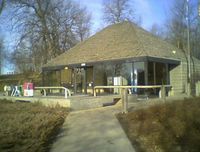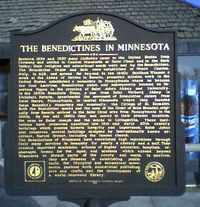Big Spunk Rest Area
This rest area is located along the eastbound path of I-94 in central Minnesota, at mile-marker 152 just west of Avon. It conforms to most Minnesota rest area styles, having separate truck and auto parking, a heavily-treed grassy area spotted with park benches and outdoor shelters, a 'pet exercise area' separated from the main area by the parking spaces, and a clean, large building with spacious restrooms.
Naming
The scatalogically humorous name comes from the equally giggle-inducing nearby body of water, "Big Spunk Lake". It can be noted that the Westbound rest area at this same mile-marker is known as "Middle Spunk Rest Area," after the nearby lake to the north.
Main Building
The rest stop building has a payphone, large restrooms, and three vending machines. The center of the large entry atrium is clumsily occupied by a large three-sided metal kiosk, approximately 5' to a side, covered with maps and housing the one payphone. The two soda vending machines are not branded on the front by any soda company: they are titled "Great River Road Scenic Byway" and "Edge of the Wilderness Scenic Byway". The Great River Road vending machine has a Pepsi sign on its side.
Historical Marker
In the outdoor foyer at the main building's entrance is a historical marker commemorating "The Benedictines in Minnesota". The sign reads:
Between 1854 and 1857 many Catholics came to the United States from Germany and settled in Central Minnesota at Saint Cloud and in the Sauk Valley; their religious and educational needs were met by the Benedictines. The Benedictine Order and Rule were established at Monte Cassino, Italy, in 529, and spread far beyond. In the 1840s Boniface Wimmer, a monk at the Abbey of Metten in Bavaria, promoted mission work in the United States, established a monastery in Pennsylvania where he became the first American Benedictine abbot, and subsequently became an important figure in the creation of Saint John’s Abbey and University. In the 1850s Benedicta Riepp, a nun from Saint Walburg Abbey in Eichstatt, Bavaria, spearheaded the movement of Benedictine sisters from Saint Marys, Pennsylvania, to central Minnesota where they founded Saint Benedict's Monastery and eventually, the College of St. Benedict. Both the Benedictine monks and the nuns of the Order of Saint Benedict, originally from Bavaria arrived in the Saint Cloud area from Pennsylvania in the 1850s. By the mid 1860s they had moved to their present locations, the nuns to Saint Joseph and the monks to Collegeville. These institutions have preserved excellent late 19th and early 20th century buildings which possess historic integrity and importance. Saint John's also preserves several buildings designed by internationally known architect, Marcel Breuer, including the famous church.
The Benedictines of Minnesota have established high reputations though their many services to humanity for nearly a century and a half. They created important academies, schools of higher education, hospitals, orphanages, homes for the aged, and missions which extend beyond Minnesota to distant parts of the country and world. In addition, they are pioneers in establishing public radio, the liturgical and ecumenical movements, pastoral work, educational publishing, arts and crafts, and the development of a world-renowned library.
Erected by the Minnesota Historical Society 1996
Internet Notariety
The name "big spunk" appeals to the least-common-demoninator humor that is common on the internet, with photos appearing on a number of popular websites:
- newcoventry's Flickr photostream
- Boner.com
- ZeFrank's The Show 'worst ever' gallery, which erroneously identifies the state as South Dakota.
- College Humor
- Anne Grgich's Blog (near end of blog entry)
Other Links
- Benedictines in Minnesota, at waymarking.com
- The Minnesota DOT official page for the Big Spunk Rest Area
- Great River Road Scenic Byway, from the National Scenic Byways Program
- Edge of the Wilderness Scenic Byway, from the National Scenic Byways Program




